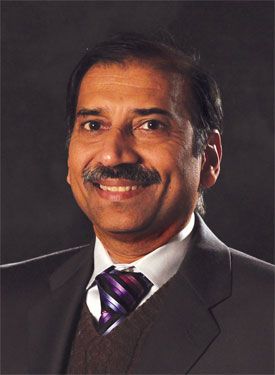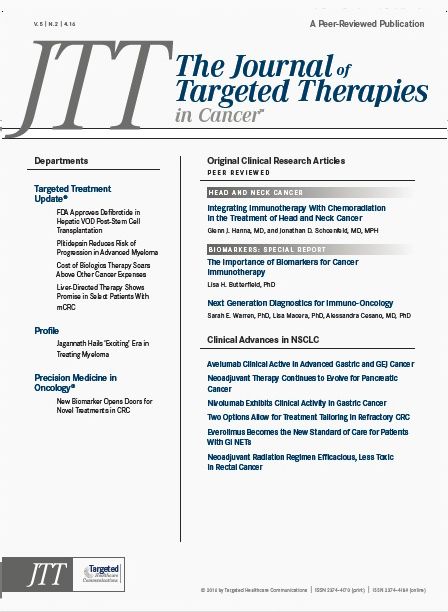Jagannath Hails 'Exciting' Era in Treating Myeloma
The therapeutic armamentarium for multiple myeloma is ever expanding, according to Sundar Jagannath, MD.
Sundar Jagannath, MD

Sundar Jagannath, MD
The therapeutic armamentarium for multiple myeloma is ever expanding, according to Sundar Jagannath, MD.
“Last year, we had four new drugs approved for the treatment of multiple myeloma, including the first-in-class histone deacetylases (HDAC) inhibitor panobinostat (Farydak), 2 monoclonal antibodieselotuzumab (Empliciti) and daratumumab (Darzalex)—and an oral proteome inhibitor ixazomib (Ninlaro),” said Jagannath, a professor of Medicine, Hematology and Medical Oncology at Mount Sinai Hospital, New York, NY. “Now is a very exciting period in multiple myeloma. Whichever way I look at it, the next 3 to 5 years are going to be very significant for myeloma and we will have better solutions for relapsed patients.”
November 2015 was a watershed month for multiple myeloma, as elotuzumab, daratumumab, and ixazomib all received FDA approvals for the disease.
First, the FDA approved daratumumab as a monotherapy for patients with multiple myeloma following at least three prior therapies, based on data from two open-label clinical trials. The CD38-targeted monoclonal antibody demonstrated a 65% 1-year overall survival (OS) rate and a 29.2% objective response rate (ORR) in the phase II MMY2002 study. In the phase I/II GEN501 study the ORR with single-agent daratumumab was 36%, median progression-free survival (PFS) was 5.6 months (95% CI, 4.2-8.1), and the 1-year OS rate was 77% (95% CI, 58-88) in pretreated patients with relapsed/refractory myeloma.
Secondly, ixazomib was approved in combination with lenalidomide (Revlimid) and dexamethasone as a treatment for patients with multiple myeloma who have received at least one prior therapy based on the phase III TOURMALINE-MM1 trial. The trial looked at 722 patients and demonstrated a median PFS of 20.6 months with ixazomib plus lenalidomide and dexamethasone compared with 14.7 months with lenalidomide and dexamethasone alone.
Finally, elotuzumab was approved for use in combination with lenalidomide and dexamethasone for patients with multiple myeloma following the failure of 1 to 3 prior therapies. This approval was based on data from the phase III ELOQUENT-2 trial, in which the 3-drug combination reduced the risk of disease progression by 30% compared with lenalidomide and dexamethasone alone.
In February 2015, the FDA approved panobinostat in combination with bortezomib (Velcade) and dexamethasone for patients with multiple myeloma who received prior treatment with bortezomib and an immunomodulatory agent, based on a prespecified subgroup analysis from the PANORAMA-1 trial. In the analysis, which looked at 193 patients, the median PFS with the panobinostat combination was 10.6 months versus 5.8 months with bortezomib and dexamethasone alone (HR, 0.52; 95% CI, 0.36-0.76).
In addition to the recently approved agents, several novel therapies are currently being investigated in multiple myeloma, including checkpoint inhibitors such as pembrolizumab (Keytruda), CAR T-cell therapy, and vaccines. In an interview withTargeted Oncology, Jagannath discussed which emerging agents he is most excited about, sequencing challenges in multiple myeloma, and the role for personalized medicine in the disease.
TARGETED ONCOLOGY:What upcoming advancements are you most excited about in multiple myeloma?
Jagannath:There are several new drugs in the pipeline that are going through rapid clinical development. This includes new classes of drugs. At the same time, immuno-oncology is expected to play a major role in multiple myeloma. Also, we now understand that these antibodies that are being approved can be used in combination with other existing drugs effectively and safely.
The future looks even brighter. At the 2015 American Society of Hematology (ASH) Annual Meeting, results were presented from a study looking at lenalidomide and dexamethasone with the checkpoint inhibitor pembrolizumab. This combination was able to put patients into remission who were refractory to currently approved agents. This means that the therapeutic armamentarium is going to widen, and there is a possibility that immunotherapy may lead to a cure for myeloma.
In the same way, we are excited thatchimeric antigen receptor T-cell(CAR T) cells against B-cell maturation antigen are coming into clinical trials in multiple myeloma. There was a CAR T-cell treatment of a single patient case report that was published inThe New England Journal of Medicine.
For the first time, we are also exploring vaccines in post-transplant multiple myeloma. People are convinced that they are looking at minimal residual disease. We may be in a situation in which the myeloma goes into a deep, complete remission. For patients who can maintain deep, complete remissions for 3 or 5 years, we can then say they are cured. These kinds of assessments are coming into play.
TARGETED ONCOLOGY:With all of these new agents, do you see potential for a personalized medicine approach?
Jagannath:Personalized medicine is very tantalizing. We are looking at whole-genome sequencing, exome sequencing, and RNA sequencing. This is evidence that myeloma has multiple clones but, at any one given time when the disease is progressing rapidly, it looks like one of the clones becomes prominent and grows rapidly and, sometimes, could be lethal.
In those cases, we may be able to repurpose a drug that is approved in another tumor type, such as lung cancer or skin cancer. This may be an appropriate therapy for myeloma. In this regard, vemurafenib (Zelboraf) has been shown to be effective for treating patients with myeloma and getting their disease under control.
I do not think the answer is personalized medicine, because there are a lot of different mutations. However, it so happens that the patients with the highest mutational burden and a lot of neoantigens are the patients who seemingly respond very well to checkpoint inhibitors. Therefore, in a way, you have a few mutations that we have a therapeutic target for, or there are too many mutations, a high mutation burden, and rapidly progressive disease. Checkpoint inhibitors may be able to work.
TARGETED ONCOLOGY:How will sequencing be determined with these new agents, and how may that change going forward?
Jagannath:Myeloma has multiple clones, so it is clear that, for a newly diagnosed patient, we should use a combination of a proteome inhibitor, an immunomodulatory drug, and dexamethasone.
In the future, we may add a monoclonal antibody to this three-drug combination. These agents are currently in phase III trials, and I have a feeling they are likely to be positive trials. That is very important. We are still incorporating transplant into the management of patients.
In the post-transplant area, we are looking at immunomodulatory molecules but, more than that, we are looking at checkpoint inhibitors and monoclonal antibodies, both of which will play a role.
For patients who relapse, we fortunately have another set of drugs. For patients who have failed on lenalidomide, for example, we have pomalidomide (Pomalyst). For patients who failed on a first-generation proteasome inhibitor such as bortezomib, they can go on a second-generation proteasome inhibitor such as carfilzomib (Kyprolis).
Then, we have completely new drugs, such as HDAC inhibitors. These are able to make patients who have become resistant to traditional drugs sensitive again when an HDAC inhibitor is added into the mix. That becomes another treatment solution. We also have the monoclonal antibodies.
My feeling is that all of these new drugs have approximately a 30% response rate, and duration of control of the disease, on average with all of these agents, is about 7 months. No one drug is a home run, although it remains to be seen what CAR T-cell therapy will do in this situation.
However, short of that, all of these different drugs are required in order to make the patient live longer and longer. That is important, because we are at the watershed period where all of these different approaches are coming into play. If any one of them hits a home run, patients who were kept alive with these different drugs may be able to be cured.
TARGETED ONCOLOGY:Will multiple myeloma eventually become more of a chronic condition?
Jagannath:In solid tumors, once a patient has failed a line of therapy, the second and third lines of therapy hardly make a dent.
In myeloma, we have different classes of drugs, so we can switch classes if something doesn’t work. That is why we are able to salvage patients after one, two, or three failures.

Survivorship Care Promotes Evidence-Based Approaches for Quality of Life and Beyond
March 21st 2025Frank J. Penedo, PhD, explains the challenges of survivorship care for patients with cancer and how he implements programs to support patients’ emotional, physical, and practical needs.
Read More